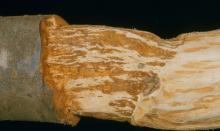See:
Cherry (Prunus spp.) - Nematode, Dagger
Cherry (Prunus spp.) - Stem Pitting
Peach (Prunus persica) - Plum Pox (Sharka)
Cause Many prune trees in Oregon are infected with one or more latent (symptomless) viruses, but we do not know how much they reduce growth and yield. OSU Plant Clinic has diagnosed several fruit and ornamental samples from Oregon with prunus necrotic ringspot virus and prune dwarf virus. It is not clear if peach mosaic virus was confirmed but was suspected in several plum and prune samples that had mosaic symptoms on the leaves. This could be due to other virus or combinations of viruses in the tree.
Plum Pox is a serious disease that has not been found in the PNW but would have major economic impact if it spreads here.
A strain of tomato ringspot virus causes a girdling and stem pitting at the graft union of infected trees. Tomato ringspot virus is spread by Xiphinema americanum and X. rivesi, nematodes. The virus may enter the orchard on infected nursery trees.
Symptoms Symptom expression varies considerably among cultivars and among strains of the same virus. Thus the top (scion) may be symptomless and the rootstock very sensitive. All other combinations also have been reported; i.e., rootstock symptomless, scion very susceptible, both scion and rootstock susceptible, and both symptomless. When a virus enters the symptomless portion, reaction may be severe when it reaches the sensitive portion. This may kill cells at the graft union and result in virus-induced incompatibility with symptoms of decline, collapse, or tree breakage.
Prunus stem pitting-Conspicuous sunken areas form on trunks of infected trees. Enlarged areas of the trunks become flattened and ridged. Pitting and grooving develops in the woody cylinder. Initial pitting in naturally infected orchard trees always is at or below ground level and extends for a short distance into the lower trunk and roots. The extent and severity of pitting, cambial and bark necrosis, enlargement of the trunk, and disorganization of xylem tissue within the woody cylinder increases with time.
Stanley prune constriction-Initial symptoms are weak growth of the terminals and yellowing and upward rolling of the foliage. Affected trees are weakly anchored in the soil. A pronounced overgrowth of the scion ("inverted shoulder") can be seen at the scion-rootstock union, while the rootstock is markedly reduced in diameter. The overgrown scion tissues are cheese-like in consistency. Numerous, abnormally large lenticels appear in the scion bark immediately above the union, below which the bark of the rootstock is necrotic in large areas or completely dead. Symptoms may develop at any time after a Stanley tree is propagated until at least the tenth year of growth. Incipient constriction may be visible in 1-year-old nursery trees, but more commonly the disorder is not evident until 1 to 5 years after the tree is planted in the orchard. Affected trees usually die within 1 to 2 years after foliage symptoms become evident.
Plum Pox-Leaf symptoms appear as pale or yellowish-green rings, spots, or leaf mottling. Plum fruit are deformed and show engraved rings, irregular lines, and poxes on the surface. Damaged fruit may drop prematurely. Bark splitting and cankers on the shoot that are brittle and degraded have also been reported. If you suspect this disease, get samples to the ODA as soon as possible.
Cultural control
- Plant certified, virus-tested (and found to be free of all known viruses) nursery stock.
Marianna 2624 as a rootstock is reported tolerant to tomato ringspot virus but has two drawbacks: it suckers profusely and has a shallow root system.
Reference Hadidi, A., Barba, M., Candresse, T., and Jelkmann, W. 2011. Virus and Virus-like Diseases of Pome and Stone Fruits. St. Paul, MN: APS Press.


